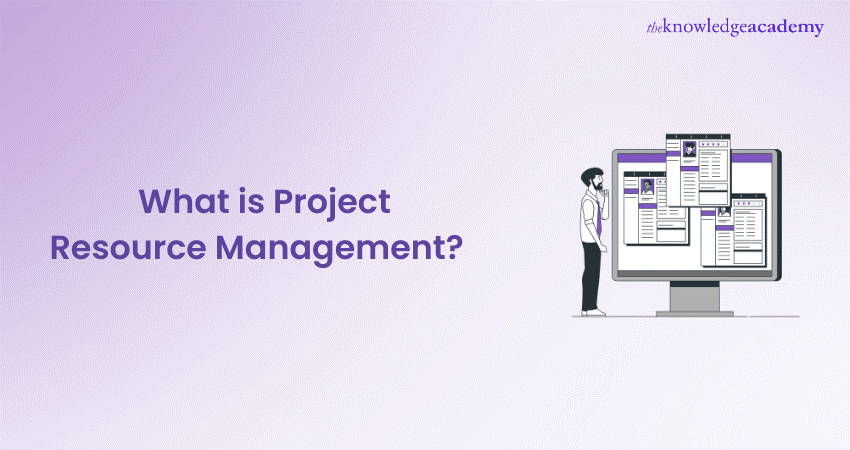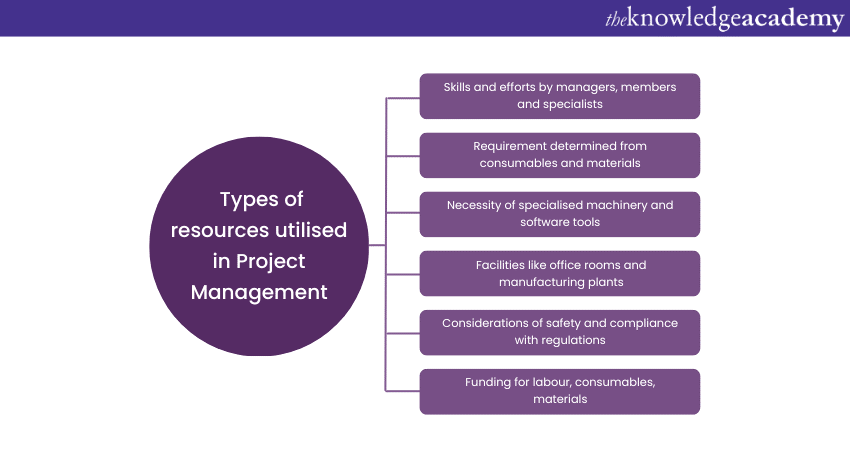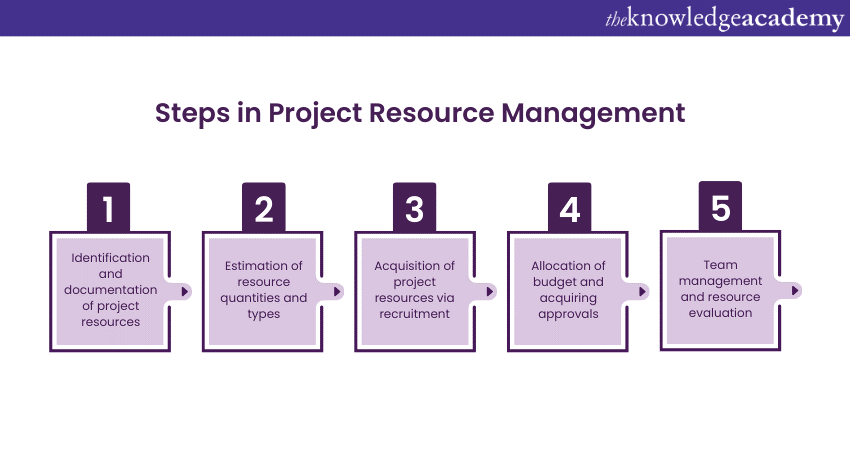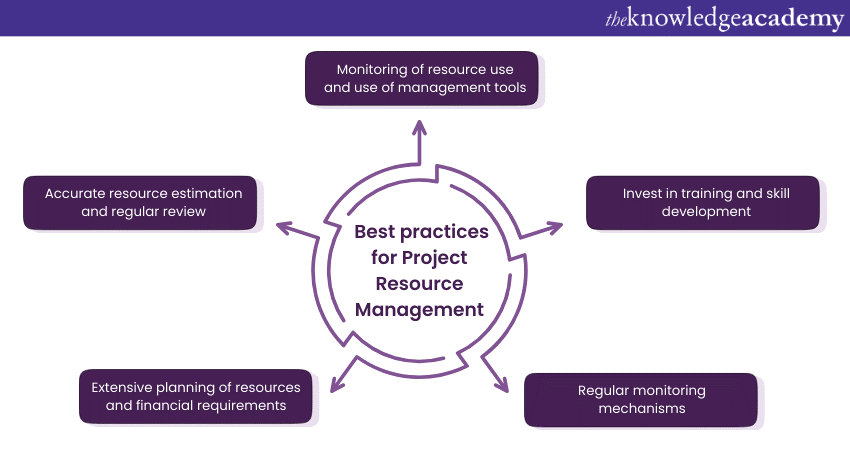We may not have the course you’re looking for. If you enquire or give us a call on 01344203999 and speak to our training experts, we may still be able to help with your training requirements.
Training Outcomes Within Your Budget!
We ensure quality, budget-alignment, and timely delivery by our expert instructors.

The strategic orchestration of resources in Project Resource Management is vital. This journey of handling and utilising resources is encapsulated in the vital discipline of Project Resource Management. A journey that requires meticulous planning, allocation, and adaptation to unforeseen challenges.
Apart from ensuring efficient allocation, Project Resource Management also guards against potential pitfalls, fostering adaptability and resilience. In this blog, you will learn how Resource Management efficiently and effectively utilise, allocate, and manage resources within a project. Read the blog to know more.
Table of Contents
1) What is Project Resource Management?
2) What is a Resource in Project Management?
3) Why is Project Resource Management important?
4) Types of resources utilised in Project Management
5) Project Resource Management Processes
6) Best practices for Project Resource Management
7) Conclusion
What is Project Resource Management?
Project Resource Management is a systematic process that involves planning, acquiring, allocating, and optimising human, material, and financial resources. It ensures efficiency, risk mitigation, and goal achievement within defined constraints. This process includes identifying required resources, creating acquisition and allocation plans, and monitoring their utilisation throughout the project lifecycle.
Effective management addresses challenges like overallocation, underutilisation, and changing requirements, optimising the triple constraint of scope, time, and cost. Ultimately, it's about making informed decisions, fostering collaboration, and adapting to dynamic environments for project success.
What is a Resource in Project Management?
A resource is anything or anyone that you need to get a job done. This could be people with specific skills or things like computers, tools, or rooms. When you plan and schedule your resources, you make sure they're used well, on time, and within budget. This helps your team work better and can reduce stress and overtime.
For example, think about a scenario where a UX Designer, a Team Leader, and a Marketing Manager have a meeting in Room X for two hours. In this case, the resources being used are the people, the room, and the time.
Why is Project Resource Management important?
As a Project Manager, your key goal is to finish projects on time and without spending too much money. A good plan for managing resources helps you do this and keeps both clients and your team happy. It also helps everyone work better and get more done.
Once you have all the people and skills you need, you have to be good at scheduling, predicting what you'll need, and planning for success. Managing resources well also means using your team's time and skills in the best way to make money. A good system for managing resources can make your team work better. Here's how:
a) Saves money: By knowing where to find the best people for the job at the lowest cost, you can spend less on each project without making it worse. You can also make sure everyone working on the project has the right skills.
b) Makes the most of your team's skills: You can predict and improve how much time your team spends on work that brings in money. That way, they spend less time on other things that don't make money.
c) Puts the right people on the right projects: Instead of using different tools for keeping track of who's working on what, you can use one system that keeps everything in one place. This helps you pick the right people for each job and finish projects on time.
d) Helps you make better choices: When you know where your team is and what they're doing, you can make better decisions about what to do next. You can also see how well everyone is doing and if there are any problems.
e) Deals with problems with resources: Sometimes, there aren't enough people with the skills you need for a project. A good system helps you decide which projects are most important and who should work on them first. This helps you use your resources well.
f) Keep track of your team's skills: A good system helps you see who has the skills you need for a project. It also helps you make sure your team is always learning new things and getting better at their jobs.
g) Plans for the future: By predicting what your team will need in the future, you can get ready for it now. This helps your team be ready for new projects and challenges.
Types of resources utilised in Project Management
Project Management pivots on three key aspects, also known as the ‘Golden Triangle’. Here are their descriptions for your in-depth understanding. Have a look:

Labour
In Project Management, labour is a fundamental resource, representing the skills, expertise, and efforts contributed by individuals within the project team. This includes project managers, team members, specialists, and any other personnel involved in the project.
Additionally, the efficient utilisation of labour resources involves strategic planning during the initiation and planning phases to identify the necessary skill sets and roles required for project success.
Moreover, Human Resource Management within projects extends beyond task assignment; it encompasses team motivation, collaboration, and Effective Communication. The success of a project often hinges on the competence and dedication of the workforce, making labour management a critical aspect of Project Resource Management.
Consumables & materials
Consumables and materials constitute tangible resources essential for project execution. This resource category encompasses items that are consumed during the project, such as office supplies, raw materials, or any items directly related to project deliverables.
Moreover, planning for consumables and materials involves determining the quantities needed, sourcing suppliers, and ensuring timely availability. Effective management of this resource type is crucial to avoid disruptions in project timelines and budget overruns.
Whether it's construction materials, software licenses, or office supplies, a comprehensive understanding of consumables and materials is vital for maintaining project momentum and quality.
Equipment & tools
Projects often require specific tools and equipment for various tasks, ranging from specialised machinery in construction projects to software tools in information technology projects.
Now, the effective utilisation of equipment and tools involves assessing project needs, procuring or renting the necessary items, and ensuring their proper maintenance and functionality throughout the project lifecycle.
Furthermore, planning for this resource type includes considerations for both routine and unexpected maintenance, as well as the potential need for upgrades or replacements. Strategic allocation and monitoring of equipment and tools contribute significantly to project efficiency and overall success.
Facilities
Facilities represent the physical spaces required to support project activities. These can include office spaces, meeting rooms, laboratories, manufacturing plants, or any environment necessary for project execution.
Proper Management of facilities involves early identification of spatial needs, securing appropriate locations, and ensuring that the working environment aligns with the project's requirements.
More importantly, facilities management also extends to considerations of safety, accessibility, and compliance with regulations. Addressing facility-related aspects in Project Resource Management is essential for creating a conducive and secure workspace that facilitates optimal project performance.
Finance
Finance is the lifeblood of any project, and effective financial Resource Management is crucial for project success. It involves budget planning, cost estimation, and financial control throughout the project lifecycle.
This resource type encompasses funding for labour, consumables, materials, equipment, facilities, and any other project-related expenses. Financial Resource Management includes monitoring expenses, managing variances, and making sure the project doesn't go over budget.
It also involves strategic decision-making regarding funding sources, cost-benefit analysis, and risk mitigation related to financial aspects. A well-managed financial aspect ensures that the project not only meets its goals but also does so within the allocated budget, contributing to overall project viability and success.
Evaluate your business needs and retain customers by signing up for our Workforce Resource Planning Training now!
Project Resource Management Processes
Project Resource Management is a dynamic process that involves meticulous planning, estimation, acquisition, team development, and continuous evaluation. Each step is crucial in ensuring that the right resources are available at the right time, contributing to the success of the project. Have a look:

1) Resource planning
The first step in Project Resource Management is thorough resource planning. This involves identifying and documenting the types and quantities of resources required for the project. Human resources, material resources, equipment, facilities, and financial resources are all considered during this phase.
A Resource Management Plan is developed, outlining how resources will be allocated, utilised, and managed throughout the project lifecycle. This plan acts as a roadmap for the project team, providing clarity on resource requirements and helping them to prevent potential issues before they arise. Effective resource planning lays the foundation for successful project execution and ensures that the project aligns with organisational goals.
2) Estimate resources
Once the resource planning is in place, the next step is to estimate the quantities and types of resources needed. This includes a detailed analysis of the project tasks and their resource requirements.
For human resources, it means identifying the specific skills and expertise required for each role. Material resources, equipment, and facilities are quantified based on project specifications.
Financial resources are estimated, considering budget constraints and potential risks. Accurate estimation is critical for avoiding overallocation or underutilisation of resources, helping the project manager make informed decisions about budgeting and scheduling.
3) Acquire resources
With the resource requirements identified and estimated, the next step is to acquire the necessary resources. This involves procuring human resources through recruitment or team assignment, obtaining material resources from suppliers, securing equipment and tools, and ensuring access to required facilities.
The financial aspect is managed by allocating the budget and obtaining necessary approvals. The acquisition phase requires careful coordination to ensure that resources are available when needed and that any potential delays or obstacles are addressed promptly. Clear communication and collaboration with stakeholders, team members, and external suppliers are essential during this step.
4) Develop and manage the team
Human resources are at the core of project success, making the development and management of the project team a critical step in Project Resource Management. This involves building a team with the right skill sets, fostering effective communication, and promoting a collaborative and motivated work environment.
Team development involves not only training and improving skills but also ensuring that team members can carry out their roles effectively. The Project Manager plays a critical part in managing team dynamics, resolving conflicts, and offering support for the team to perform at its best. When a team is well-managed and works together smoothly, it is more likely to achieve project goals efficiently.
5) Continuously evaluate the resources
The final step in Project Resource Management is continuous evaluation. This ongoing process involves monitoring resource utilisation, assessing team performance, and identifying any deviations from the Resource Management Plan.
Regular evaluation allows project managers to detect and address resource-related issues promptly. It includes reviewing project progress, analysing resource allocation against the plan, and making adjustments as needed.
Continuous evaluation ensures that the project remains adaptable to changes, risks are mitigated, and resources are optimised throughout the project lifecycle. This iterative approach contributes to overall project success and enhances the organisation's ability to learn and improve its Resource Management practices.
Improve your interpersonal corporate skills by signing up for our Introduction to Supervising a team Course now!
Best practices for Project Resource Management
Effective Project Resource Management is critical for achieving project goals within defined constraints. Implementing best practices ensures optimal resource utilisation, minimises risks and enhances overall project success. Here are key best practices in Project Resource Management:

Thorough resource planning
Initiate projects with comprehensive resource planning, identifying human, material, financial, and technological requirements. Develop a Resource Management Plan outlining allocation strategies, dependencies, and contingency measures.
Integrated project and resource planning
Align project plans with resource availability to prevent conflicts and bottlenecks. Regularly update project and resource plans to adapt to changing requirements and constraints.
Resource estimation accuracy
Invest time in accurate resource estimation, considering historical data, expert judgment, and industry benchmarks. Regularly review and adjust resource estimates based on project progress and changes in scope.
Dynamic resource allocation
Continuously monitor resource utilisation and adjust allocations based on project priorities and evolving requirements. Use Resource Management tools to visualise and optimise allocation in real-time.
Skills mapping and development
Match team members' skills to project tasks to enhance efficiency. Invest in training and skill development to address gaps and improve the overall competency of the project team.
Effective communication and collaboration
Establish transparent communication channels to ensure all team members are aware of project goals, resource needs, and changes. Foster a collaborative team culture to enhance coordination and problem-solving.
Risk Management
Conduct thorough risk assessments related to resource availability and constraints. Develop risk mitigation plans to address potential challenges, such as unexpected changes in resource availability.
Regular monitoring and reporting
Implement regular monitoring mechanisms to track resource utilisation against the plan. Generate and analyse reports to identify trends, address issues promptly, and make data-driven decisions.
Investment in resource management tools
Utilise advanced Project Management and resource planning tools to streamline processes. Leverage technology for real-time visibility into resource allocation, facilitating more informed decision-making.
Continuous improvement
Develop a culture of continuous improvement by conducting post-project reviews. Capture lessons learned from each project, find areas to make better, and use what you learn to improve how you manage resources in the future.
Foster proactive planning and mitigate risks by signing up for our Project Management Courses | Training & Certifications now!
Conclusion
In conclusion, the effective orchestration of project success hinges on the adept application of best practices in Project Resource Management. By embracing thorough planning, dynamic allocation, and continuous improvement, organisations can navigate challenges, optimise efficiency, and ensure the seamless integration of resources to achieve project goals.
Get comfortable with managing your finances by signing up for our Financial Management Training now!
Frequently Asked Questions

Project Management helps by planning for what might happen later so you're ready. It also helps teams work better together and finish tasks on time. With good Project Management, you can tackle new challenges and be ready for whatever comes your way.

Many careers benefit from Project Management skills, especially those involving organising tasks, meeting deadlines, and working with teams. This includes fields like construction, IT, healthcare, and marketing, among others.

The Knowledge Academy takes global learning to new heights, offering over 30,000 online courses across 490+ locations in 220 countries. This expansive reach ensures accessibility and convenience for learners worldwide.
Alongside our diverse Online Course Catalogue, encompassing 17 major categories, we go the extra mile by providing a plethora of free educational Online Resources like News updates, Blogs, videos, webinars, and interview questions. Tailoring learning experiences further, professionals can maximise value with customisable Course Bundles of TKA.

The Knowledge Academy’s Knowledge Pass, a prepaid voucher, adds another layer of flexibility, allowing course bookings over a 12-month period. Join us on a journey where education knows no bounds.

The Knowledge Academy offers various Project Management Courses, including Introduction to Project Management Course, Project Management Office (PMO) Fundamentals Course and Certified Digital Services Project Manager Course. These courses cater to different skill levels, providing comprehensive insights into What is a Project Communication Plan.
Our Project Management Blogs covers a range of topics offering valuable resources, best practices, and industry insights. Whether you are a beginner or looking to advance your Business Improvement skills, The Knowledge Academy's diverse courses and informative blogs have you covered.
Upcoming Project Management Resources Batches & Dates
Date
 Project Management Certification Course
Project Management Certification Course
Fri 17th May 2024
Fri 21st Jun 2024
Fri 19th Jul 2024
Fri 16th Aug 2024
Fri 13th Sep 2024
Fri 11th Oct 2024
Fri 8th Nov 2024
Fri 13th Dec 2024







 Top Rated Course
Top Rated Course



 If you wish to make any changes to your course, please
If you wish to make any changes to your course, please


